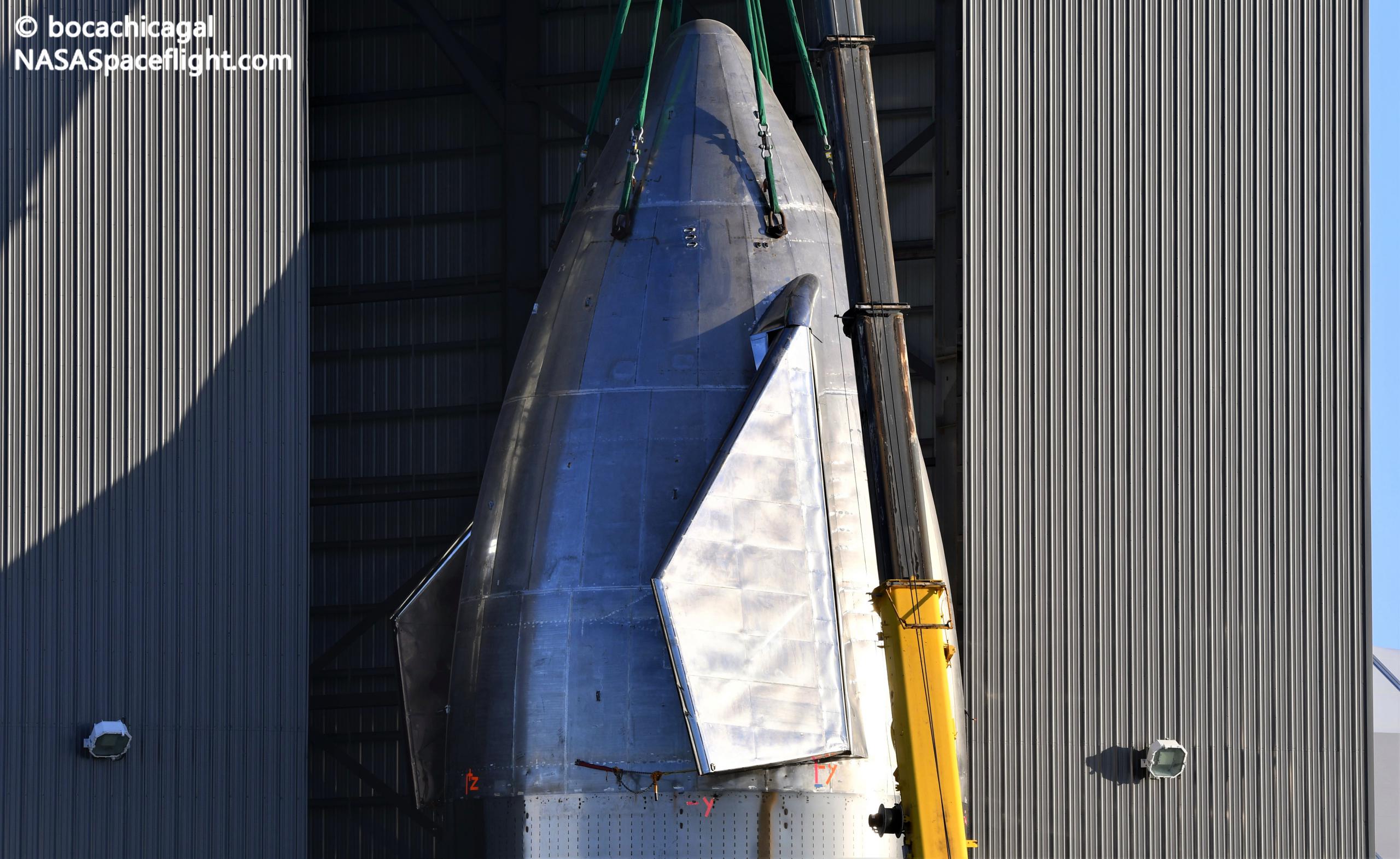
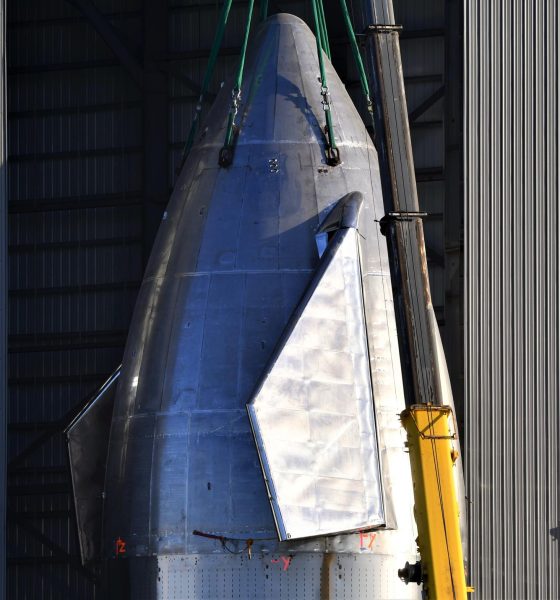
News
SpaceX Starship go for nosecone installation after historic static fire
SpaceX CEO Elon Musk has confirmed that Starship and Raptor’s first triple-engine static fire was a success, opening the door for nosecone installation.
Around 3:13 am CDT, October 20th, Starship serial number 8 (SN8) successfully fired up three Raptor engines less than two hours after completing the first successful three-engine preburner test. With zero direct human intervention, SpaceX remotely detanked the rocket’s cryogenic liquid methane and oxygen propellant – the remnants now too warm to be used again in a controlled manner. In an hour or less, SpaceX engineers combed through the data produced and concluded that all three Raptor engines were healthy after their partial ignition test.
Effectively reset to a stable state, SpaceX once again proceeded to load Starship SN8’s propellant tanks with a small amount of supercooled LOx and LCH4, almost exactly mirroring the preburner test. Around 50 minutes after the recycle commenced and 25 minutes after propellant loading kicked off, Starship SN8 ignited three Raptors simultaneously – a major milestone for any rocket engine. Static fire now completed, Starship SN8 has been cleared to become the first operational prototype to reach its full 50m (~165 ft) height.
Shortly before Musk confirmed SN8’s static fire success, SpaceX canceled a preexisting October 20th static fire window and scheduled several new road closures on Wednesday, October 21st. Unlike the company’s recent static fire closures, all but one of which ran from 9pm to 6am, SpaceX’s new Wednesday closures are scheduled from 7am to noon and 3pm to 5pm local (CDT).
While a minor data point, in context with Starship SN8’s static fire success, the closures alone made it clear that SpaceX planned to begin installing Starship SN8’s nosecone on October 21st. Musk confirmed that assumption a few hours after those road closures were published.
It’s not entirely clear but most observers are assuming that Wednesday’s 7am-12pm window is needed to transport a large, new crane the ~2 miles between SpaceX’s Boca Chica factory and launch facilities. Starship SN8’s stacked nose section would then likely be installed on the same self-propelled mobile transporters (SPMT) and rolled to the launch pad from 3pm to 5pm, after which the nose would be lifted and stacked atop Starship SN8.
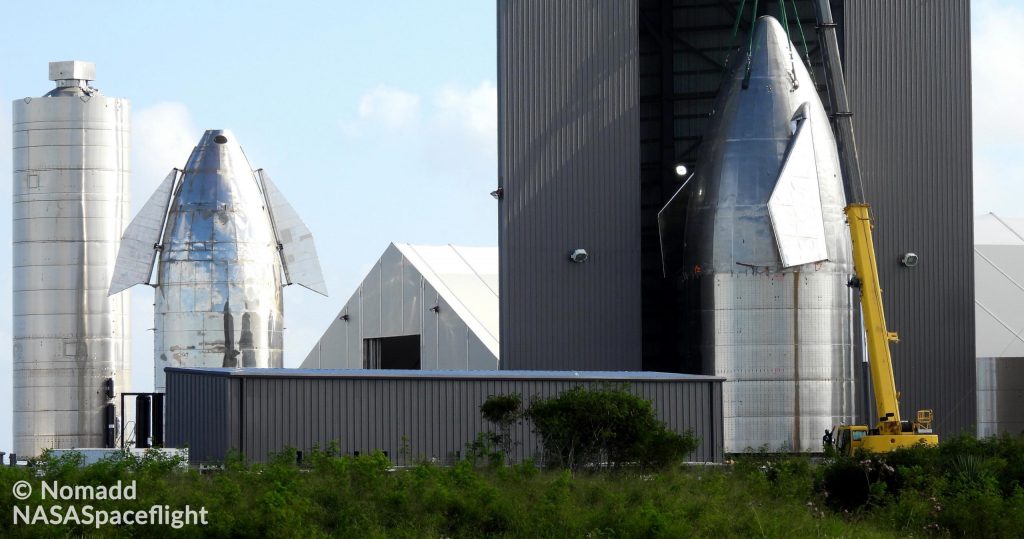
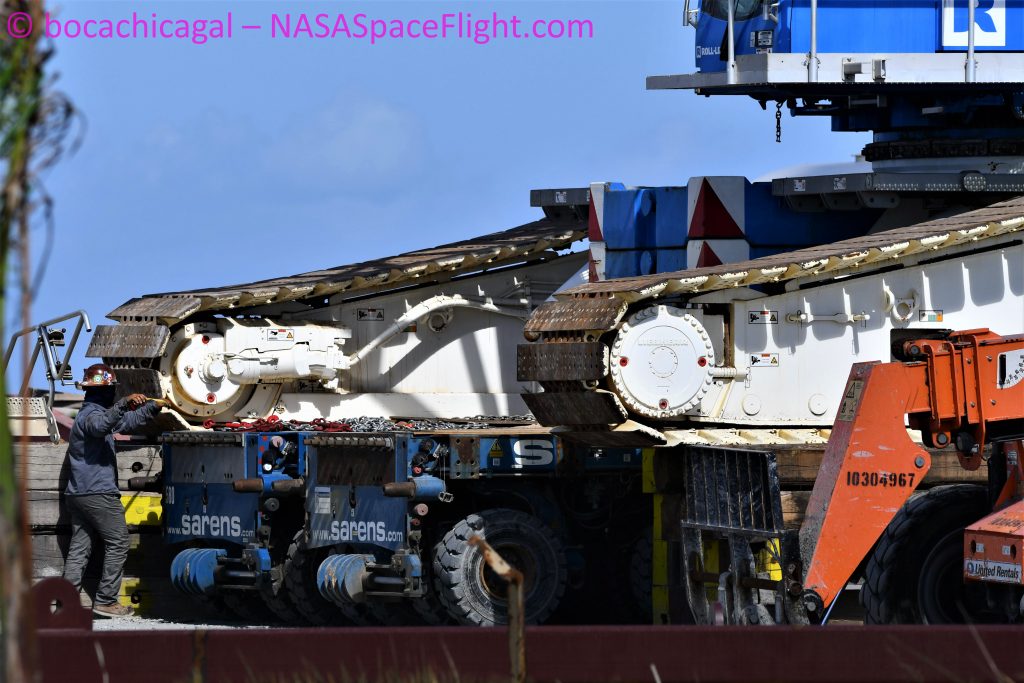
SpaceX has only fully stacked a Starship prototype once before when Mk1’s nose section was temporarily mated to its tank section to be the centerpiece of CEO Elon Musk’s October 2019 Starship event. It’s unclear why SpaceX wouldn’t simply use one of the mobile cranes its rented for Starship tank section operations (and stacking Mk1) in the past, so it remains to be seen what Wednesday’s road closures will actually be used for.
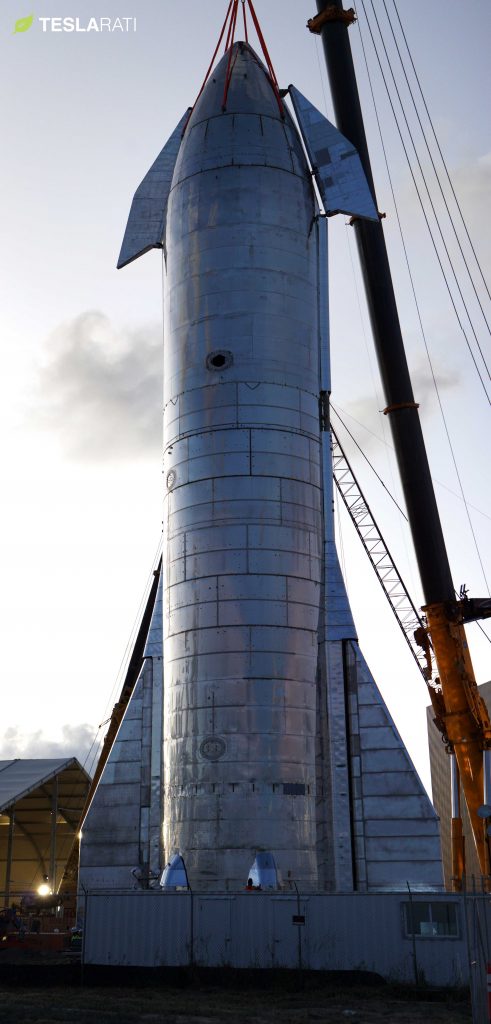
SpaceX’s road closure plans end with a wildcard, however. Once installed, the plan is to perform a second triple-Raptor static fire while only drawing propellant from SN8’s header tanks – small internal tanks designed to hold landing propellant, one of which is situated at the tip of Starship’s nosecone. On October 21st and 22nd, SpaceX still has two 9pm-6am closures scheduled for “SN8 static fire” testing. Filed early on October 20th, before SN8’s successful static fire, the most likely explanation is a simple clerical error or miscommunication, with Cameron County or SpaceX failing to properly communicate that those subsequent static fire test windows are no longer needed.
If retaining the static fire closures was intentional, it would mean that SpaceX – likely at Musk’s urging – intends to install Starship SN8’s nosecone in a matter of hours. It’s almost inconceivable that Starship SN8’s nosecone – outfitted with multiple gas thrusters, forward flaps powered by Tesla motors, a liquid oxygen header tank, vents, and plenty of plumbing – can be installed and made ready for testing in less than 12 hours. Barring a surprise method of mating SN8’s nose and tank sections, the nosecone will have to be welded to the rest of SN8 and the weld inspected – typically a multi-day process.
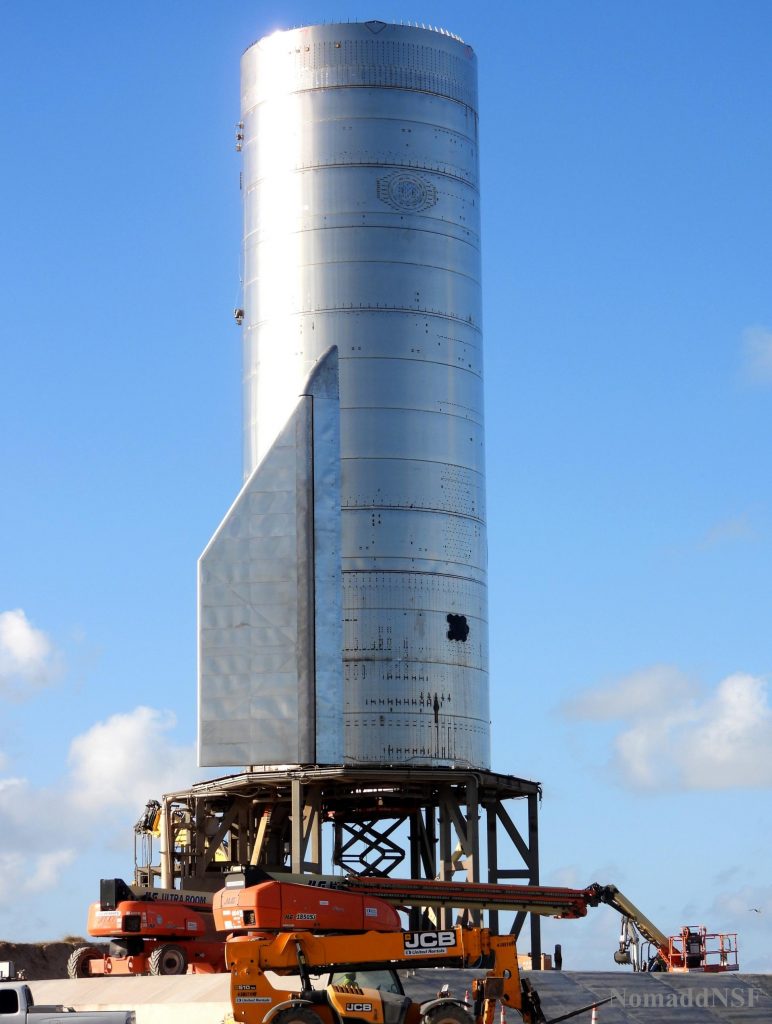
Regardless, given how quickly SpaceX moves and how dead-set CEO Elon Musk is at pushing limits and breaking barriers, it seems reasonable to assume that Starship SN8 may be fully integrated and ready for a second static fire test just a handful of days from now. Once completed, SN8 will be ready to attempt Starship’s first high-altitude flight test, launching to ~15 km (~9.3 mi) to attempt an untested skydiver-style descent and landing.

Elon Musk
Elon Musk and James Cameron find middle ground in space and AI despite political differences
Musk responded with some positive words for the director on X.

Avatar director James Cameron has stated that he can still agree with Elon Musk on space exploration and AI safety despite their stark political differences.
In an interview with Puck’s The Town podcast, the liberal director praised Musk’s SpaceX achievements and said higher priorities must unite them, such as space travel and artificial intelligence. Musk responded with some positive words for the director on X.
A longtime mutual respect
Cameron and Musk have bonded over technology for years. As far back as 2011, Cameron told NBC News that “Elon is making very strong strides. I think he’s the likeliest person to step into the shoes of the shuttle program and actually provide human access to low Earth orbit. So… go, Elon.” Cameron was right, as SpaceX would go on to become the dominant force in spaceflight over the years.
Even after Musk’s embrace of conservative politics and his roles as senior advisor and former DOGE head, Cameron refused to cancel his relationship with the CEO. “I can separate a person and their politics from the things that they want to accomplish if they’re aligned with what I think are good goals,” Cameron said. Musk appreciated the director’s comments, stating that “Jim understands physics, which is rare in Hollywood.”
Shared AI warnings
Both men have stated that artificial intelligence could be an existential threat to humanity, though Musk has noted that Tesla’s products such as Optimus could usher in an era of sustainable abundance. Musk recently predicted that money and jobs could become irrelevant with advancing AI, while Cameron warned of a deeper crisis, as noted in a Fox News report.
“Because the overall risk of AI in general… is that we lose purpose as people. We lose jobs. We lose a sense of, ‘Well, what are we here for?’” Cameron said. “We are these flawed biological machines, and a computer can be theoretically more precise, more correct, faster, all of those things. And that’s going to be a threshold existential issue.”
He concluded: “I just think it’s important for us as a human civilization to prioritize. We’ve got to make this Earth our spaceship. That’s really what we need to be thinking.”
News
Blue Origin announces Super-Heavy New Glenn 9×4 to Rival SpaceX Starship
The announcement followed the company’s successful NG-2 launch on November 13.

Blue Origin has revealed plans to develop New Glenn 9×4, a “super heavy” rocket designed to deliver 70 metric tons to low-Earth orbit and directly compete with SpaceX’s Starship.
The announcement followed the company’s successful NG-2 launch on November 13, which deployed NASA’s ESCAPADE (Escape and Plasma Acceleration Dynamics Explorers) Mars mission and landed the first stage.
Upgraded engines and reusability
As noted in a Universe Today report, Blue Origin will roll out upgraded BE-4 engines producing 640,000 lbf each, up from 550,000 lbf, starting with NG-3. This should boost the New Glenn rocket’s total first-stage thrust to 4.5 million pounds. Upper-stage BE-3U engines are expected to improve from 320,000 lbf to 400,000 lbf over the next few flights as well.
“These enhancements will immediately benefit customers already manifested on New Glenn to fly to destinations including low-Earth orbit, the Moon, and beyond. Additional vehicle upgrades include a reusable fairing to support increased flight rates, an updated lower-cost tank design, and a higher-performing and reusable thermal protection system to improve turnaround time,” Blue Origin noted.
New Glenn “Super Heavy” 9×4
The super-heavy New Glenn 9×4, with nine BE-4s on the booster, four BE-3Us on the upper stage, will feature an 8.7-meter payload fairing. Blue Origin expects New Glenn 9×4 to be capable of transporting 70 metric tons to LEO, 14 tons to GSO, and 20 tons to trans-lunar injection, as noted by the company in a blog post. This is very impressive, as New Glenn 9×4’s capacity exceeds Falcon Heavy, SpaceX’s largest rocket available to consumers today. Falcon Heavy is capable of carrying up to 64 metric tons to low Earth orbit in a fully expendable configuration.
That being said, SpaceX’s Starship’s capacity is extremely impressive. As per SpaceX, Starship is designed to be capable of carrying up to 100-150 metric tonnes to orbit in its fully reusable configuration. At its expendable configuration, Starship’s capacity enters unheard-of territory, with SpaceX stating that the vehicle could transport 250 metric tonnes of cargo.
News
Tesla FSD approved for testing in Nacka, Sweden, though municipality note reveals aggravating detail
Nacka, Sweden, a municipality just a few miles from Stockholm, has given its approval for FSD tests.

Tesla has secured approval for FSD testing in an urban environment in Sweden. As per recent reports from the Tesla community, Nacka, Sweden, a municipality just a few miles from Stockholm, has given its approval for FSD tests.
A look at the municipality’s note regarding FSD’s approval, however, reveals something quite aggravating.
FSD testing approval secured
As per Tesla watcher and longtime shareholder Alexander Kristensen, Nacka is governed by the Moderate Party. The shareholder also shared the municipality’s protocol notes regarding approval for FSD’s tests.
“It is good that Nacka can be a place for test-driving self-driving cars. This is future technology that can both facilitate mobility and make transportation cheaper and more environmentally friendly,” the note read.
The update was received positively by the Tesla community on social media, as it suggests that the electric vehicle maker is making some legitimate headway in releasing FSD into the region. Sweden has been particularly challenging as well, so securing approval in Nacka is a notable milestone for the company’s efforts.
Aggravating details
A look at the notes from Nacka shows that FSD’s proposed tests still met some opposition from some officials. But while some critics might typically point to safety issues as their reasons for rejecting FSD, those who opposed the system in Nacka openly cited Tesla’s conflict with trade union IF Metall in their arguments. Fortunately, Nacka officials ultimately decided in Tesla’s favor as the company’s issues with the country’s unions are a completely different matter.
“The left-wing opposition (S, Nackalistan, MP and V) voted no to this, referring to the fact that the applicant company Tesla is involved in a labor market conflict and does not want to sign a collective agreement. We believe that this is not an acceptable reason for the municipality to use its authority to interfere in a labor law conflict.
“Signing a collective agreement is not an obligation, and the company has not committed any crime. The municipality should contribute to technological development and progress, not work against the future,” the note read.









